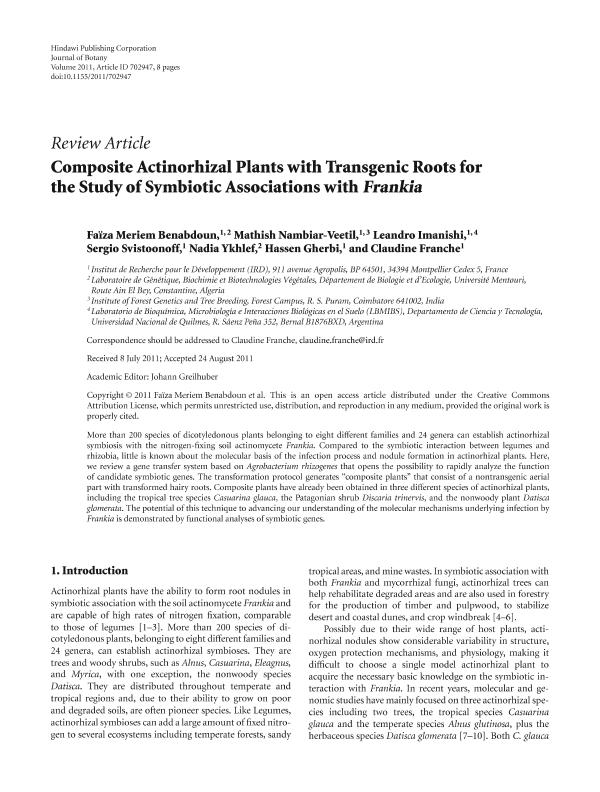Mostrar el registro sencillo del ítem
dc.contributor.author
Meriem Benabdoun, Faiza
dc.contributor.author
Nambiar Veetil, Mathish
dc.contributor.author
Imanishi, Leandro Ezequiel

dc.contributor.author
Svistoonoff, Sergio
dc.contributor.author
Ykhlef, Nadia
dc.contributor.author
Gherbi, Hassen
dc.contributor.author
Franche, Claudine
dc.date.available
2023-04-10T11:10:40Z
dc.date.issued
2011-08
dc.identifier.citation
Meriem Benabdoun, Faiza; Nambiar Veetil, Mathish; Imanishi, Leandro Ezequiel; Svistoonoff, Sergio; Ykhlef, Nadia; et al.; Composite Actinorhizal Plants with Transgenic Roots for the Study of Symbiotic Associations with Frankia; Hindawi Publishing Corporation; Journal of Botany; 8-2011; 1-8
dc.identifier.issn
2090-0120
dc.identifier.uri
http://hdl.handle.net/11336/192957
dc.description.abstract
More than 200 species of dicotyledonous plants belonging to eight different families and 24 genera can establish actinorhizal symbiosis with the nitrogen-fixing soil actinomycete Frankia. Compared to the symbiotic interaction between legumes and rhizobia, little is known about the molecular basis of the infection process and nodule formation in actinorhizal plants. Here, we review a gene transfer system based on Agrobacterium rhizogenes that opens the possibility to rapidly analyze the function of candidate symbiotic genes. The transformation protocol generates ?composite plants? that consist of a nontransgenic aerial part with transformed hairy roots. Composite plants have already been obtained in three different species of actinorhizal plants, including the tropical tree species Casuarina glauca, the Patagonian shrub Discaria trinervis, and the nonwoody plant Datisca glomerata. The potential of this technique to advancing our understanding of the molecular mechanisms underlying infection by Frankia is demonstrated by functional analyses of symbiotic genes.
dc.format
application/pdf
dc.language.iso
eng
dc.publisher
Hindawi Publishing Corporation

dc.rights
info:eu-repo/semantics/openAccess
dc.rights.uri
https://creativecommons.org/licenses/by-nc-sa/2.5/ar/
dc.subject
BIOLOGICAL NITROGEN FIXATION
dc.subject
ACTINORHIZAL PLANTS
dc.subject
FRANKIA
dc.subject
AGROBACTERIUM RHIZOGENES
dc.subject
COMPOSITE PLANTS
dc.subject.classification
Biología Celular, Microbiología

dc.subject.classification
Ciencias Biológicas

dc.subject.classification
CIENCIAS NATURALES Y EXACTAS

dc.title
Composite Actinorhizal Plants with Transgenic Roots for the Study of Symbiotic Associations with Frankia
dc.type
info:eu-repo/semantics/article
dc.type
info:ar-repo/semantics/artículo
dc.type
info:eu-repo/semantics/publishedVersion
dc.date.updated
2023-04-05T15:35:51Z
dc.journal.pagination
1-8
dc.journal.pais
Egipto

dc.description.fil
Fil: Meriem Benabdoun, Faiza. Université Mentouri; Argelia
dc.description.fil
Fil: Nambiar Veetil, Mathish. No especifíca;
dc.description.fil
Fil: Imanishi, Leandro Ezequiel. Universidad Nacional de Quilmes. Departamento de Ciencia y Tecnología; Argentina. Consejo Nacional de Investigaciones Científicas y Técnicas; Argentina
dc.description.fil
Fil: Svistoonoff, Sergio. No especifíca;
dc.description.fil
Fil: Ykhlef, Nadia. Université Mentouri; Argelia
dc.description.fil
Fil: Gherbi, Hassen. No especifíca;
dc.description.fil
Fil: Franche, Claudine. No especifíca;
dc.journal.title
Journal of Botany
dc.relation.alternativeid
info:eu-repo/semantics/altIdentifier/doi/http://dx.doi.org/10.1155/2011/702947
dc.relation.alternativeid
info:eu-repo/semantics/altIdentifier/url/https://www.hindawi.com/journals/jb/2011/702947/
Archivos asociados
